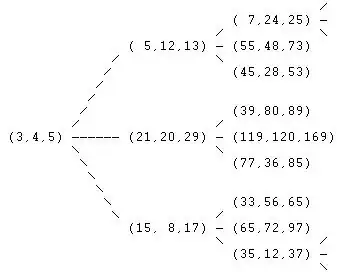I would like to construct infinitely many Pythagorean triples where c = b+3. Proving there are infinitely many should not be difficult but finding the right form for a b and c is proving to be difficult. I have tried modifying the typical a=n^2 + m^2 b=2nm c=n^2-m^2 but that hasn't worked out for me yet. Any suggestions on what to start with? Thanks!
-
Do you mean to have $a$ as the hypotenuse? That is, are your triples $b^2+c^2=a^2$ and you want $c=b+3$. Or could it also be $a^2+b^2=c^2$ where $c=b+3$? I ask since the usual choice of letters for Pythagorean triples is to have $c$ be the hypotenuse, but in your attempt of the post it seems you use $a$ for the hypotenuse. – coffeemath Dec 17 '13 at 05:44
-
Pythagorean triplets have the form $(A(M^2-N^2), 2AMN, A(M^2+N^2)).$ Put $A=3$ and $M-N=1.$ – DanielWainfleet May 28 '17 at 22:23
3 Answers
We look first at the simpler problem of Pythagorean triples $(x,y,z)$ where $z=y+1$.
Such a triple must be primitive, and therefore $z=u^2+v^2$, $y=2uv$, for some $u$ and $v$. Then $u^2+v^2=2uv+1$, giving $u=v+1$. That gives the triple $x=2v+1$, $y=2v(v+1)$, $z=2v^2+2v+1$.
Multiply each entry by $3$ to get infinitely many triples $(a,b,c)$ where $c=b+3$.
All triples $(a,b,c)$ with $c=b+3$ must be of this form. For any triple has shape $(k(u^2-v^2), 2kuv, k(u^2+v^2))$ for some $u,v$ that are relatively prime. The possibility $k(u^2+v^2)=k(u^2+v^2)+3$ need not be considered, since $k(u^2+v^2)$ and $k(u^2-v^2)$ always have the same parity.
Putting $k(u^2+v^2)=2kuv+3$, we get $k(u-v)^2=3$, which forces $k=3$.
- 507,029
Another way is to specialize the ascent in the ternary tree of Pythagorean triples (see below). Specializing $\,z = y+3\,$ in the $\rm\color{#c00}{\,formula\,}$below yields the following generation rule
$$ x^2 + y^2 = (y+3)^2\ \Rightarrow\ (6-x)^2 + Y^2 = (Y+3)^2,\quad Y = y-2x+6 $$
This yields $\ (-3,0,3)\to (-9, 12, 15)\to (-15, 36, 39)\to (-21, 72, 75)\to (-27, 120, 123)\,\ldots$ which are simply $\,3\,$ times the triples $\,(a,b,b+1),$ in the highest branch in the tree.
$\qquad\qquad$ 
The reflection that yields the descent in the triples tree is the following
$\quad\quad \color{#c00}{(x,y,z)\; \mapsto} (x,y,z) - 2 \dfrac{(x,y,z)\cdot(1,1,1)}{(1,1,1)\cdot(1,1,1)} (1,1,1)$
$\quad\quad\quad\quad\quad\quad = (x,y,z) - 2 \; (x+y-z) \; (1,1,1)$
$\quad\quad\quad\quad\quad\quad = \color{#c00}{(-x-2y+2z, \; -2x-y+2z, \; -2x-2y+3z)}$
We ascend the tree by inverting this reflection, combined with trivial sign-changing reflections:
$\quad\quad (-3,+4,5) \mapsto (-3,+4,5) - 2 \; (-3+4-5) \; (1,1,1) = ( 5,12,13)$
$\quad\quad (-3,-4,5) \mapsto (-3,-4,5) - 2 \; (-3-4-5) \; (1,1,1) = (21,20,29)$
$\quad\quad (+3,-4,5) \mapsto (+3,-4,5) - 2 \; (+3-4-5) \; (1,1,1) = (15,8,17)$
Continuing in this way enables one to reflectively generate the entire tree of primitive Pythagorean triples. This has a beautiful geometric interpretation in terms of reflections - see the prior linked post and see here for sums of four squares.
- 272,048
First, note that we have $a^2=c^2-b^2=6b+9$. We want this to be a perfect square; it's easy to see that we must have $3|b$ and modular considerations show we have to have $2|n$; a little computation suggests to us that $b=6n(n+1)$ is always a perfect square, with $a^2=36n^2+36n+9=9(2n+1)^2$. Now $a^2+b^2=36n^2+36n+9+36n^4+72n^3+36n^2=9(4n^4+8n^3+8n^2+4n+1) = (6n^2+6n+3)^2=(b+3)^2$.
So the requested triple is $(6n+3,6n^2+6n,6n^2+6n+3)$. I doubt there are others, but I'm not going to prove that.